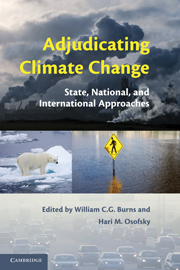Book contents
- Frontmatter
- Contents
- Foreword
- Acknowledgments
- Adjudicating Climate Change
- 1 Overview: The Exigencies That Drive Potential Causes of Action for Climate Change
- PART I SUBNATIONAL CASE STUDIES
- PART II NATIONAL CASE STUDIES
- PART III SUPRANATIONAL CASE STUDIES
- 11 The World Heritage Convention and Climate Change: The Case for a Climate-Change Mitigation Strategy beyond the Kyoto Protocol
- 12 The Inuit Petition as a Bridge? Beyond Dialectics of Climate Change and Indigenous Peoples' Rights
- 13 Bringing Climate Change Claims to the Accountability Mechanisms of International Financial Institutions
- 14 Potential Causes of Action for Climate Change Impacts under the United Nations Fish Stocks Agreement
- 15 Climate Change Litigation: Opening the Door to the International Court of Justice
- 16 The Implications of Climate Change Litigation: Litigation for International Environmental Law-Making
- 17 Conclusion: Adjudicating Climate Change across Scales
- Index
- References
12 - The Inuit Petition as a Bridge? Beyond Dialectics of Climate Change and Indigenous Peoples' Rights
Published online by Cambridge University Press: 25 August 2009
- Frontmatter
- Contents
- Foreword
- Acknowledgments
- Adjudicating Climate Change
- 1 Overview: The Exigencies That Drive Potential Causes of Action for Climate Change
- PART I SUBNATIONAL CASE STUDIES
- PART II NATIONAL CASE STUDIES
- PART III SUPRANATIONAL CASE STUDIES
- 11 The World Heritage Convention and Climate Change: The Case for a Climate-Change Mitigation Strategy beyond the Kyoto Protocol
- 12 The Inuit Petition as a Bridge? Beyond Dialectics of Climate Change and Indigenous Peoples' Rights
- 13 Bringing Climate Change Claims to the Accountability Mechanisms of International Financial Institutions
- 14 Potential Causes of Action for Climate Change Impacts under the United Nations Fish Stocks Agreement
- 15 Climate Change Litigation: Opening the Door to the International Court of Justice
- 16 The Implications of Climate Change Litigation: Litigation for International Environmental Law-Making
- 17 Conclusion: Adjudicating Climate Change across Scales
- Index
- References
Summary
INTRODUCTION
The rapid pace of climate change in the Arctic poses serious challenges for the Inuit peoples living there. A petition filed with the Inter-American Commission on Human Rights in December 2005 on behalf of Inuit in the United States and Canada claims that U.S. climate change policy violates their rights. Upon filing the petition, Sheila Watt-Cloutier, Chair of the Inuit Circumpolar Conference, made a statement at the 2005 Conference of Parties of the United Nations Framework Convention on Climate Change. She summarized the severity of the stakes involved as follows:
What is happening affects virtually every facet of Inuit life – we are a people of the land, ice, snow, and animals. Our hunting culture thrives on the cold. We need it to be cold to maintain our culture and way of life. Climate change has become the ultimate threat to Inuit culture.…How would you respond if an international assessment prepared by more than 300 scientists from 15 countries concluded that your age-old culture and economy was doomed, and that you were to become a footnote to globalization?
The Inter-American Commission provided a two-paragraph response to the petition on November 16, 2006, that “the information provided does not enable us to determine whether the alleged facts would tend to characterize a violation of the rights protected by the American Declaration.
- Type
- Chapter
- Information
- Adjudicating Climate ChangeState, National, and International Approaches, pp. 272 - 291Publisher: Cambridge University PressPrint publication year: 2009
References
- 4
- Cited by



